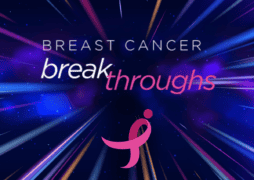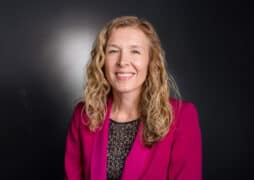Laura Esserman, M.D., M.B.A., is a breast cancer oncologist who has devoted her career to integrating research and clinical care, conducting science-based, patient-centered clinical trials to personalize care and improve breast cancer patient outcomes. She leads the landmark I-SPY series of clinical trials that are advancing the science of individualizing treatment to improve outcomes. She says it is time for us to be bold and push harder for change so breast cancer treatment and care continues to evolve, and every woman and man with breast cancer receives the care that is right for them.
Esserman, Director of the UCSF Breast Care Center, Alfred A. de Lorimier Endowed Chair in General Surgery, and Professor of Surgery and Radiology, University of California, San Francisco, is this year’s recipient of Susan G. Komen’s Brinker Award for Scientific Distinction in Clinical Research. She is being recognized with Komen’s highest honor for the advancements she’s made in breast cancer research and medicine. She recently spoke with Susan G. Komen about her research.
Komen: Could you briefly describe your research and what you’re seeking to accomplish?
Esserman: We no longer believe that breast cancer is one disease thanks to so many people who have done so much research in this area. We know there is a wide variety of breast cancer subtypes, and patients can have disease ranging from benign (not likely to spread) to very aggressive, and we now treat each subtype differently. My work focuses on how to personalize breast health care from screening to treatment, and prevention based on an individual’s breast cancer risk factors.
Komen: How do you personalize treatment for breast cancer patients?
Esserman: We want to shape treatment so that we are doing enough but not too much for patients. I’m focused on driving drug development through a clinical trial called I-SPY, so we can prevent metastatic disease. We’re trying to figure out, based on the type of disease, what drugs ought to go to which patients. When someone’s had a great response, to de-escalate treatment, and if someone hasn’t had a good response, to escalate treatment. When people have less aggressive disease, we want our treatments to be more appropriate to her or his situation.
Komen: And what about screening?
Esserman: If breast cancer isn’t one disease, and we know all women don’t have the same risk of developing breast cancer in their lifetime, why is it that we still approach screening as if one size fits all? In spite of everything we’re doing, more than 40,000 women a year are still dying of breast cancer. So, we have to do better, and we have to have some urgency about it. The WISDOM Study is all about testing whether a personalized approach based on an individual’s relative risk can help us improve the way we screen for breast cancer and really improve our approach to prevention.
We have 30,000 women enrolled in this trial, and we would love to get to 100,000. Something every woman (who does not have breast cancer) can do to help us change the future is to join the WISDOM study. It is open across the United States and anyone can join at any time by going to WISDOM Study (https://www.thewisdomstudy.org/). We’re testing what is currently the gold standard in many people’s minds, which is annual mammography screening starting at 40, compared to a personalized approach based on a woman’s individual risk factors for breast cancer, like her breast density, genetic mutations, race/ethnicity, and family health history. We’re looking at when to start screening, how often to screen, what modality of screening to use and for whom should we be targeting preventive interventions.
Komen: Are there other aspects on the continuum of care where we can make changes?
Esserman: Although we have made a lot of gains, especially recently, in treatment, there are opportunities for change in every aspect of patient care. We need to have that sense of urgency and be willing to change. We’ve learned enough that I think it’s time to be bolder and have more research focused on how we make change in a safe and effective way. I think we need to reclassify tumors to help figure out who’s going to respond to what therapy and how to drive combinations of therapies that can be both more effective and less toxic. But as we start to understand more about how to treat these cancers, we can also start to think about who’s at risk for those subtypes of cancer. We’re excited about the future; we think there’s so much opportunity for improvement.
Change is hard and can be a barrier to advancing care. I think that comes from thinking that what we are doing is good enough. But are the treatments and inventions what patients really want and need? As an active clinician, I can tell you most people don’t like the choices we are giving them. So, I think we have to push harder for quicker, more adaptive and better tailored change. I’m excited about what I see coming in the pipeline – new, and better targeted agents and more opportunity to understand risk and response. The greatest asset we have in breast cancer is women themselves. They have always led the way. They have always insisted on change and new options. I also think the voice of the patient is absolutely paramount. I’ve always had advocates as a huge part of everything I’ve done.
Komen: As you said, one of the ways we learn about better ways of doing things is through clinical trials. Did you find a diverse group of women who were interested in participating in the trials you’re leading?
Esserman: Having diversity in your trials is absolutely essential. Trials have to reflect the population impacted by the disease and make sure you have opportunities to learn across the whole population. The differences in race, in ethnicity, can actually be really important for helping us understand how to treat certain tumor types. Because certain tumor types are more common in different groups, and it helps you learn how to better treat people, and hopefully, in the future, how to screen and prevent breast cancer. I think it’s essential to bring your advocates into the planning and the design phases of your trials, but you also need to involve people in the trial itself to make sure your trials reflect the diversity of the population of the United States.
As for whether women want to participate in trials, I have found that when you take the time to explain what you’re doing and why you’re doing it, and when it’s really clear you’re doing it to try and find a better path forward, people hear that. They resonate with it, and they want that, too. We also need to give people time to adjust to their diagnosis and not ask them to be make decisions in a rush. In I-SPY 2, we have a screening phase (where we gather all the necessary information) and then a randomization phase, which gives women a chance to make it possible to be on study, without losing time, but then also to think about whether they want to participate once they are ready to be randomized. The advocates helped us create this part of the design. When I started my career, I fundamentally believed there was an opportunity to build a model of care that would be very patient centric, very science centric, and very improvement driven, and that’s what I set out to do.
Komen: Are there changes clinicians can make to increase patient participation in clinical trials?
Esserman: It’s important for us to make sure our trials are open and get to the places where the patients are. I think there are several reasons why a small fraction of patients participates in clinical trials. One reason is lack of awareness and failure to appreciate that tomorrow’s therapies are in trials today, which is why we built breastcancertrials.org, so we could help women find trials that are right for them. Another reason is that a lot of the patients get their care where the trials aren’t. We have to think creatively about how to get our trials out to more sites and to more places in the community where people get their care and have collaborations to allow that to happen. I think one of the things we need to stop doing is stop frightening people and making them feel like there’s a great urgency and they have to make a decision tomorrow. That’s just almost never true. And we have to make access to trials easier. Thirty-seven states have laws that enable people to go to institutions where trials are being conducted, and insurance has to cover standard of care costs. People should know about this. California was the first (SB37) and the author of that bill is in Congress and is working on a bill to make this standard across the country.
Komen: What drew you to the field of breast cancer?
Esserman: I had worked on both science and policy when I was in medical school, and someone I had worked with at Stanford Business School had recruited me to come and learn some of the techniques of modern management and apply them back to medicine, which is where a lot of my ideas for running trials and accelerating knowledge assurance came from. I had been doing both trauma critical care and then focused a lot on cancer. I was fortunate to work with Dr. Ron Levy, an expert in lymphoma and the father of immunoncology. I chose to work with him because he was doing such innovative work and I wanted to learn how to bring fresh solution to solve complex problems and bring innovation to breast cancer treatment.
In the late 80s and early 90s, breast cancer patients were just treated terribly. They were taken to the operating room and had no idea whether they would get a mastectomy or not, the surgeries were brutal, they weren’t included in the conversation, no information was given to them, there were no coordinated places for them to go to get their care. As a clinician at that time, I felt like there was such an opportunity for improvement. And there was such an opportunity to bring science together with personalized care by creating centers of excellence.
These centers, I thought, would be the perfect places to build that model of high-touch, patient-engaged breast cancer care that’s all about research, learning and changes to improve care. Rather than separate visits to an oncologist and a surgeon and a radiologist, the patient could get everything they needed in one place. This benefits the patient, and we will improve how we treat each breast cancer patient as an individual. That really became the model that’s driven my work. It’s about treating the cancer, but also really understanding and tailoring treatment to each patient, and learning, together, how to constantly improve what we do.



